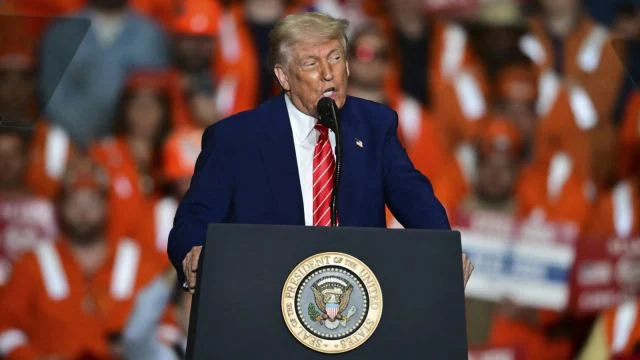US Imposes 25% Tariff on Indian Products from August 1: What It Means for India
In a significant development, U.S. former President Donald Trump has declared 25% duty on all Indian imports, from August 1, 2025. The declaration has raised serious alarm among Indian export industries, trade experts, and international trade communities.
Trump made the announcement at a rally in Ohio, accusing India of continuing to have “unfair” trade practices and continuing to purchase Russian oil and weapons. Trump referred to it as a “corrective step” intended to balance out trade between the two nations.

Why the U.S. Took This Step?
Trump said India has been imposing high import tariffs on American products while enjoying access to the American market. Trump also attacked India’s increasing energy and defense cooperation with Russia in defiance of international sanctions.
In Trump’s opinion, the steps taken by India are against U.S. interests and international sanctions on Russia. This forced the Trump administration to not only impose a 25% tariff, but also think about additional penalties to defense imports and energy trade.
Modern Economic Imperialism”: Iran Condemns U.S. Over Sanctions on Indian Firms
Which Indian Industries Are Impacted?
The tariff will hit directly at some of India’s major export industries. They are textiles, pharmaceuticals, automobile parts, jewellery, and electronics.
India’s exports to the U.S. aggregated $83 billion in 2024. With the additional tariff, close to $60 billion worth of merchandise may lose competitiveness owing to increased costs of goods in the U.S. market.
Segments such as apparel and jewellery, which have marginal margins of profit, might witness cancellation of huge orders, firing of workers, and curbs on production.
Government of India Responds
India’s Commerce Ministry released a curt statement describing the action as “unilateral and unjustified.” The government has promised exporters and stakeholders that it is considering all options very carefully.
Top officials indicate India will raise the issue through diplomatic channels and take it to the World Trade Organization (WTO) if necessary. There is also speculation about accelerating bilateral trade agreements with Europe and the Gulf to counter balance losses.
Sources add that a retaliatory tariff on certain U.S. products has not been excluded, but India won’t respond in haste with hostility.
What Industry Leaders Are Saying?
Exporters are sounding alarm. The Apparel Export Promotion Council (AEPC) has cautioned that this could lead to more than 500,000 job losses in the garment sector alone.
Jewellery exporters, who export almost 70% of their produce to the U.S., claim that demand will plummet if U.S. consumers switch to Thailand or China. In the pharma industry, businesses are confident that interdependence will ultimately lead to a compromise. India exports cheap generics that are crucial to American healthcare. This tariff move comes shortly after India and the U.S. failed to finalize a free trade agreement earlier this year. Talks broke down over American demands for full access to Indian agriculture, dairy, and auto markets. India, on the other hand, sought a reduction in U.S. tariffs on steel, aluminium, and textiles, which the U.S. refused to concede.
Experts say this imposition of tariffs could be the start of a bigger U.S.–India trade standoff, particularly with elections approaching in both nations.
Global Response and Outlook
The world has responded with caution. China has referred to the step as “a warning to developing economies.” Russia, however, hailed India for asserting strategic autonomy.
The European Union is concerned, particularly given that India just entered into a free trade agreement with the UK and is in negotiations with the EU. This could compel India to look East and West for new trade alliances.
The action is viewed by most analysts as a trend towards economic nationalism, as tensions rise between political and global trade agendas.
What’s Next?
India is now calculating the precise effect across sectors. Export councils have been requested to provide detailed numbers, and urgent meetings have been conducted with the commerce ministry officials.
Financial experts opine that if the tariffs remain in effect for over a quarter, India’s growth rate of exports may fall by 3–4%, impacting the overall GDP outlook.
In spite of the challenge, India is likely to diversify export markets, promote digital trade, and venture into rupee-based oil payments in order to decrease exposure to the U.S. currency.
Conclusion
The 25% tariff is more than a trade matter it’s a diplomatic signal. It is a turning point in the India–U.S. relationship, particularly since both countries need to balance strategic partnerships and domestic interests.
India must now balance keeping its exporters safe, retaining its relationships with the West, and upholding its independent foreign policy – all simultaneously.
With more revelations forthcoming, the attention will be on the way India negotiates, improvises, and potentially recharts its trade strategy in a more fractured global economy.
Would you like a version of this written up as a full blog post with internal links, SEO meta tags, a featured image, and tags (for sites like WordPress or Blogger)?